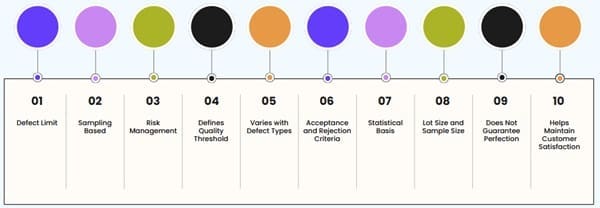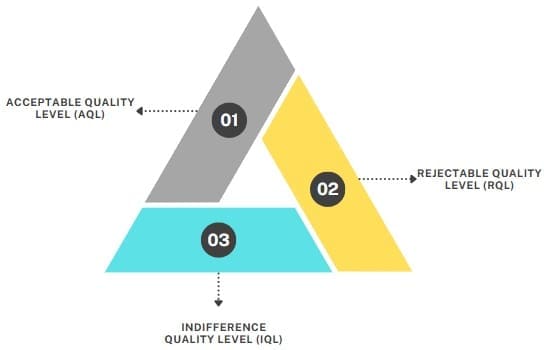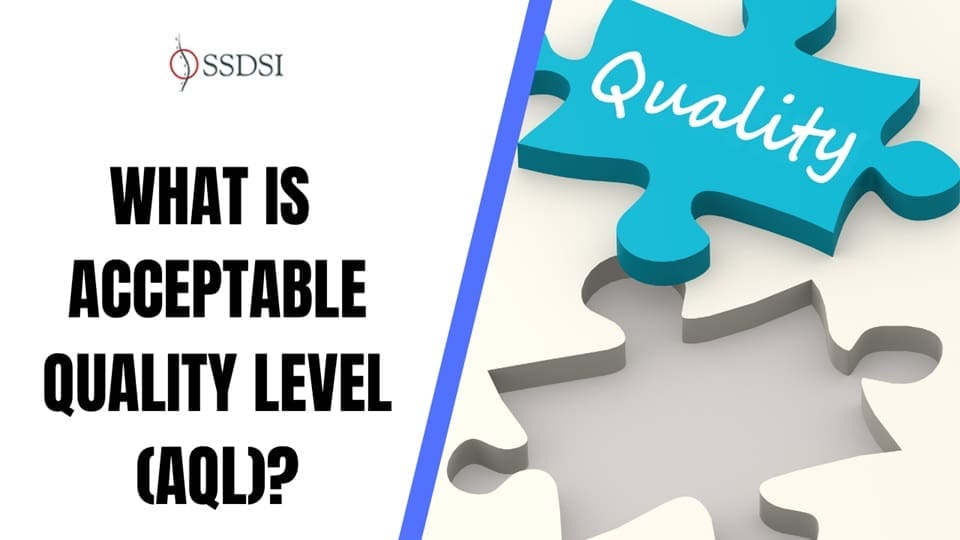The concept of Acceptable Quality Level (AQL) defines the maximum allowable number of defects in a product lot that inspectors can consider acceptable during an inspection. AQL sets a threshold for the percentage of defective items that a customer can tolerate while still accepting the product lot.
It is crucial in quality control to determine the acceptability of a lot and ensure that it meets the minimum quality standards.
Statistical sampling methods determine AQL. These methods help assess whether a lot should be accepted or rejected.
AQL provides a framework for decision-making, but it does not guarantee that every defect will be caught.
Instead, it provides a guideline to measure the overall quality of a batch or lot.
Table of contents
What is an Acceptable Quality Level (AQL)?
The Acceptable Quality Level (AQL) defines the maximum number of defective items allowed in a batch of products that inspectors can still consider acceptable. Statistical sampling determines the acceptable quality level for a product. Quality control uses AQL to decide whether to accept or reject a lot based on the number of defects found in a sample.
In simple terms, AQL helps define the worst tolerable quality level, meaning it specifies the maximum permissible defects in a product that a customer can still accept. It serves as a threshold, ensuring that the quality of goods meets a minimum standard while also acknowledging that it is unrealistic to expect every product to be perfect.
Characteristics of Acceptable Quality Level (AQL)

- Defect Limit: AQL sets a limit on the percentage of defective items in a batch. For example, if a lot has an AQL of 1%, it means that up to 1% of the items can be defective and still be accepted. Any defect rate above this threshold would result in the rejection of the lot.
- Sampling Based: Random sampling determines AQL for the product lot. Inspectors do not examine the entire lot; they select only a sample of items. They then check the sample for defects, and use the number of defective items to decide whether to accept or reject the entire lot.
- Risk Management: AQL helps manage two types of risks:
- Producer’s Risk (Type I error): The risk of rejecting a good lot.
- Consumer’s Risk (Type II error): The risk of accepting a bad lot.
The sampling plan determines the acceptable probability of these risks.
- Defines Quality Threshold: The AQL represents the worst quality level that remains acceptable. It helps determine whether the product meets the required quality standards or should be rejected based on the number of defective units in the sample.
- Varies with Defect Types: Different types of defects (critical, major, minor) are assigned different AQL values. For instance, critical defects (those that could compromise safety) may have a lower AQL value than minor defects (those that don’t significantly affect product function). The AQL for major defects is typically higher than for critical defects but lower than for minor defects.
- Acceptance and Rejection Criteria: The AQL sets the acceptance number and rejection number for a lot. The acceptance number represents the maximum number of defective units allowed in the sample for accepting the lot. The rejection number represents the minimum number of defective units that would cause the entire lot to be rejected.
- Statistical Basis: AQL is based on statistical methods, particularly probability theory, to estimate the quality of the entire lot from a small sample. It uses the concept of Operating Characteristic (OC) curves, which show the probability of accepting a lot based on its defect level. These curves help in understanding the risks of accepting or rejecting a lot based on its quality.
- Lot Size and Sample Size: The AQL value helps determine the sample size to be tested from a lot. Larger lots typically require a larger sample size for accurate inspection. Standardized tables, such as those from the International Organization for Standardization (ISO), generally provide the sampling plan. These tables link AQL values to lot sizes and defect types.
- Does Not Guarantee Perfection: AQL does not guarantee that every product in the lot is defect-free. It simply ensures that the lot has a defect rate within the acceptable limit. Even with a low AQL, individual units may still have defects, but the sampling results deem the lot as a whole acceptable.
- Helps Maintain Customer Satisfaction: The AQL value helps balance the cost of quality control with customer expectations. By setting an appropriate AQL, manufacturers can ensure that their products meet customer requirements without unnecessarily rejecting good lots or inspecting every unit.
How Does AQL Work?
AQL works by evaluating a random sample from a lot to decide the lot as a whole. The system accepts the lot if the number of defects found in the sample is within the acceptable limit set by AQL. If the number of defects exceeds this limit, the system rejects the lot. The sampling typically depends on the size of the lot and the criticality of the defects being assessed.
Sampling plans are chosen from statistical tables. These plans take into account the lot size, the AQL value, and the level of inspection required. For instance, AQL can be set at different levels depending on the type of defect – critical, major, or minor. Critical defects, which pose a significant risk to safety, have a lower AQL than minor defects.
AQL and Sampling Risks
Two primary sampling risks need to be considered:
- Risk of accepting bad lots: This is the risk that a defective lot will be accepted based on sampling.
- Risk of rejecting good lots: This is the risk that a lot without many defects will be rejected due to sampling.
To address these risks, an Operating Characteristic (OC) curve is used. The OC curve plots the probability of accepting a lot based on its quality level. An ideal OC curve would have a sharp distinction between good and bad lots, but this is often not achievable. In reality, there is always some uncertainty in the acceptance decision.
Limitations of Acceptable Quality Levels
While AQL is widely used, it has several limitations. One of the primary drawbacks is that AQL does not reflect how the process itself is performing. AQL evaluates only the specific lot in question, not the overall consistency of the production process.
Moreover, AQL sampling plans are not always efficient, especially when high levels of quality are required. In many cases, they are costly and time-consuming. Organizations may mistakenly believe that AQL sampling can ensure a higher quality than is realistically achievable.
Another issue with AQL is that it may lead to the testing of quality in a product. This means that even if a product has passed the sampling test, it may still contain defects that could impact customer satisfaction.
Additionally, AQL often results in rejecting lots due to common-cause process variability, which does not necessarily indicate a problem with the overall quality of the product.
Understanding the Different Quality Levels

AQL is often categorized into three main levels:
Acceptable Quality Level (AQL): This percentage represents the maximum number of defective units that customers can accept. They often set it based on their requirements and the type of product being inspected.
Rejectable Quality Level (RQL): This represents a quality level at which a lot is deemed unacceptable. RQL typically associates with higher risks and aims to reject lots that fall below acceptable standards.
Indifference Quality Level (IQL): This represents a quality level between AQL and RQL. It is the point where the probability of acceptance and rejection is equal.
The relationship between these levels is essential for determining the acceptance criteria for each lot. They provide a statistical framework to assess the likelihood of accepting or rejecting a batch based on the number of defects found in a sample.
Also See: Lean Six Sigma Certification Programs, Richmond, Virginia
Role of Sampling and Random Selection
For an AQL test to be valid, it is critical to select samples randomly from the lot. This ensures that the sample is representative of the overall quality of the lot. Non-random sampling can lead to biased results and inaccurate conclusions about the quality of the lot.
Additionally, neither random sampling nor 100% inspection guarantees that every defect will be detected. In fact, studies have shown that even 100% inspection is only about 80% effective. This highlights the limitations of using sampling methods alone to ensure high product quality.
Example of Acceptable Quality Level Testing
Consider a situation where a manufacturer is testing a lot of 75 items with an AQL of 4%. According to the ANSI/ASQC Z1.4-1993 standards, the sample size for this lot is 13. If the sample exceeds the acceptance number of defective units, the system will reject the lot. If the sample stays within the acceptable threshold for defects, the system will accept the lot.
However, this example illustrates how uncertain the AQL process can be. For example, if the failure rate in the lot is actually 7.6%, the sampling method may still accept the lot due to its limitations. AQL testing can give a false sense of security, and businesses must understand the risks involved in this approach.
Challenges with AQL Testing
AQL testing can be inefficient and costly, especially when dealing with large production lots or high-quality standards. In some cases, the sample size required to achieve an accurate assessment of the lot’s quality is impractically large, making the process expensive and time-consuming.
Furthermore, AQL testing does not always protect the customer’s interests. It is possible that a defective lot may pass inspection, or a good lot may be rejected. This makes AQL sampling plans less reliable in ensuring consistent product quality.
Transitioning Away from AQL
Many organizations are beginning to move away from traditional AQL sampling plans. The primary reason for this shift is that AQL often fails to reflect the actual performance of the manufacturing process. By relying solely on sampling, businesses may overlook broader issues with their production methods that could lead to defects in future lots.
Instead, organizations are exploring alternative methods such as statistical process control (SPC), which focuses on monitoring and improving the overall process rather than relying on sampling alone.
Final Words
In conclusion, AQL serves as a widely used method for quality control, but it has several limitations. While it offers a statistical framework for deciding whether to accept or reject a lot, it does not guarantee the detection of every defect or ensure that the process consistently produces high-quality products.
AQL sampling plans can be inefficient, costly, and prone to errors, making it essential for organizations to explore other quality control methods for more reliable and cost-effective results.
By understanding the limitations of AQL and considering alternative approaches, businesses can improve their quality control processes and ensure that their products meet the highest standards.

About Six Sigma Development Solutions, Inc.
Six Sigma Development Solutions, Inc. offers onsite, public, and virtual Lean Six Sigma certification training. We are an Accredited Training Organization by the IASSC (International Association of Six Sigma Certification). We offer Lean Six Sigma Green Belt, Black Belt, and Yellow Belt, as well as LEAN certifications.
Book a Call and Let us know how we can help meet your training needs.



















